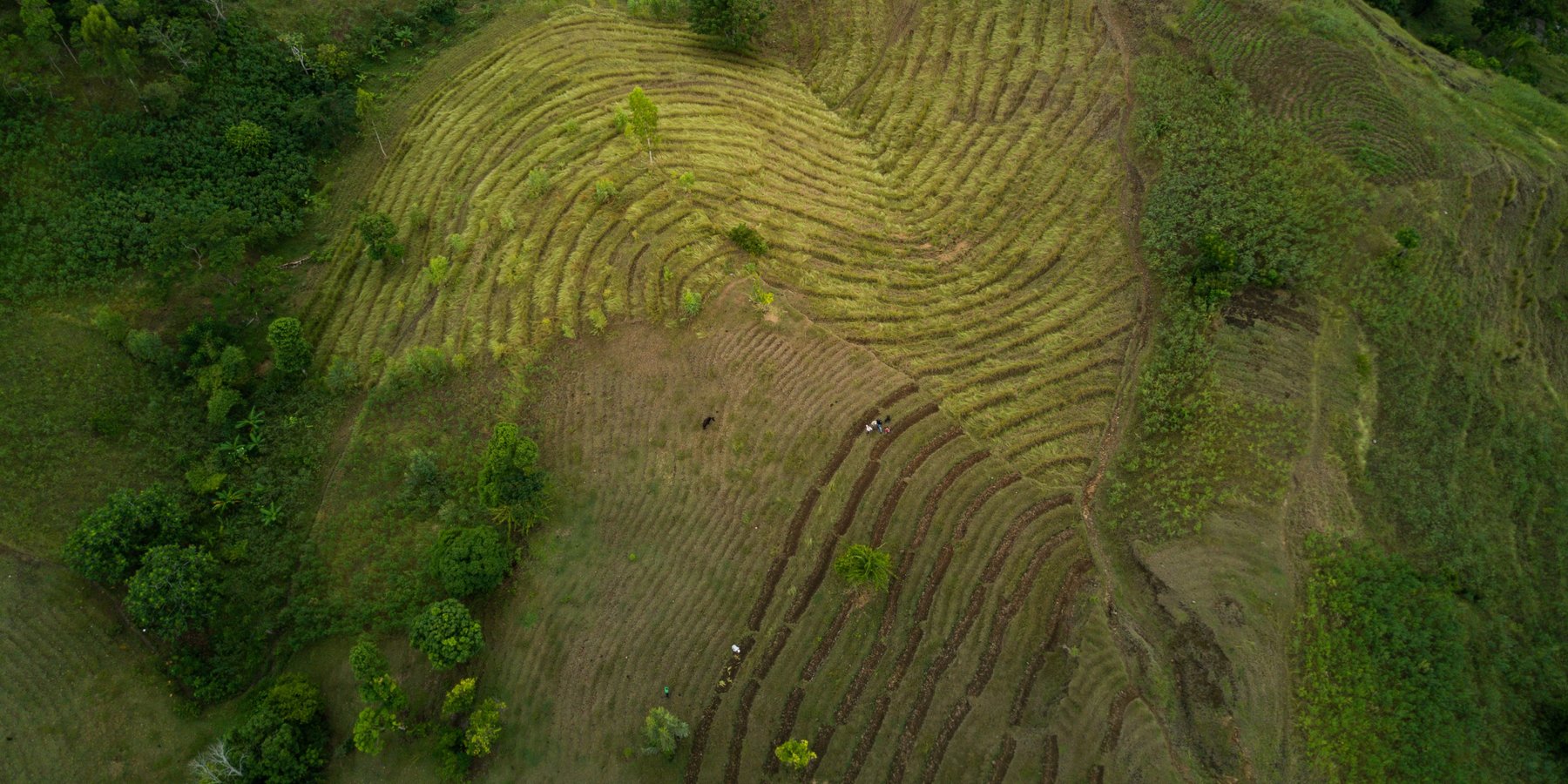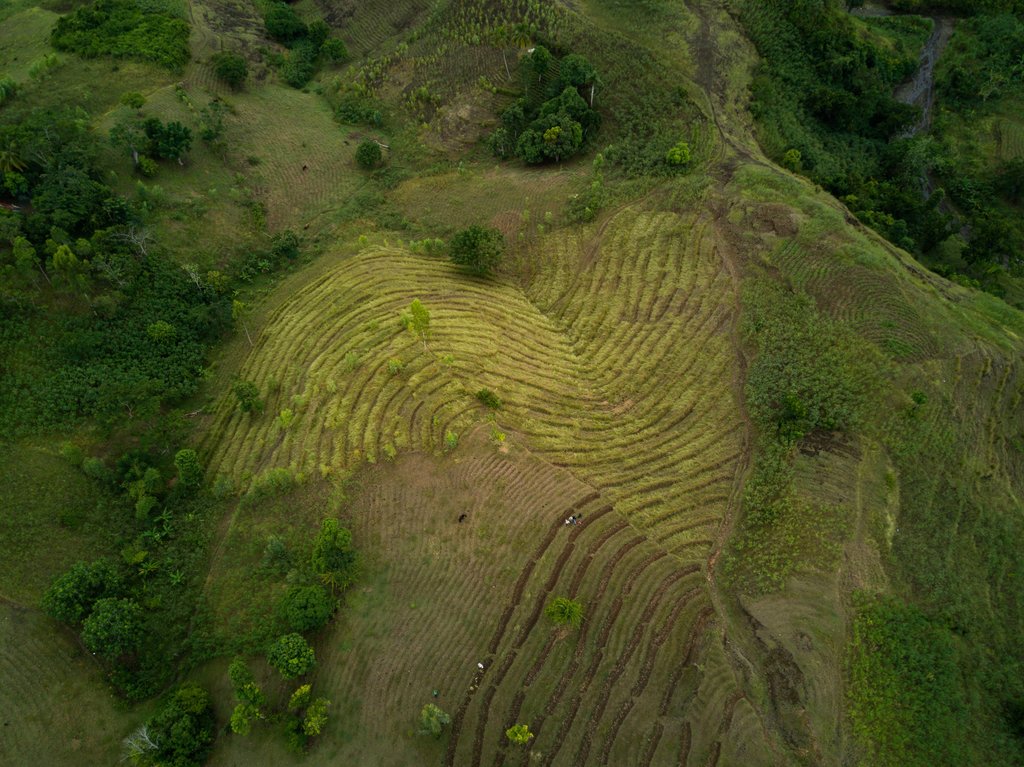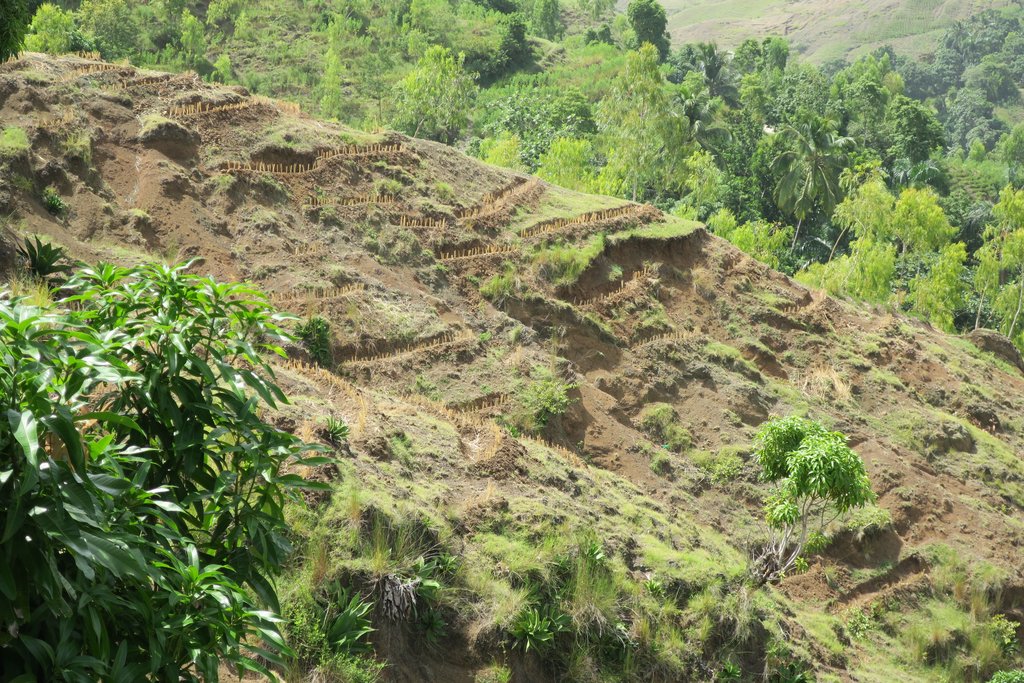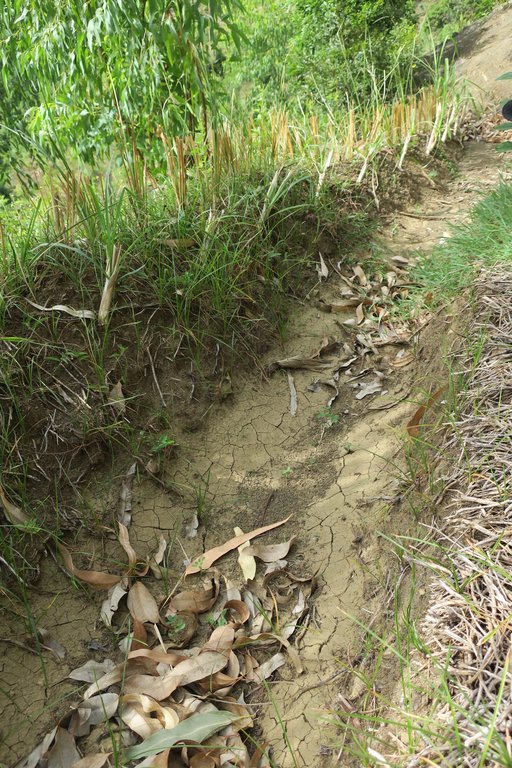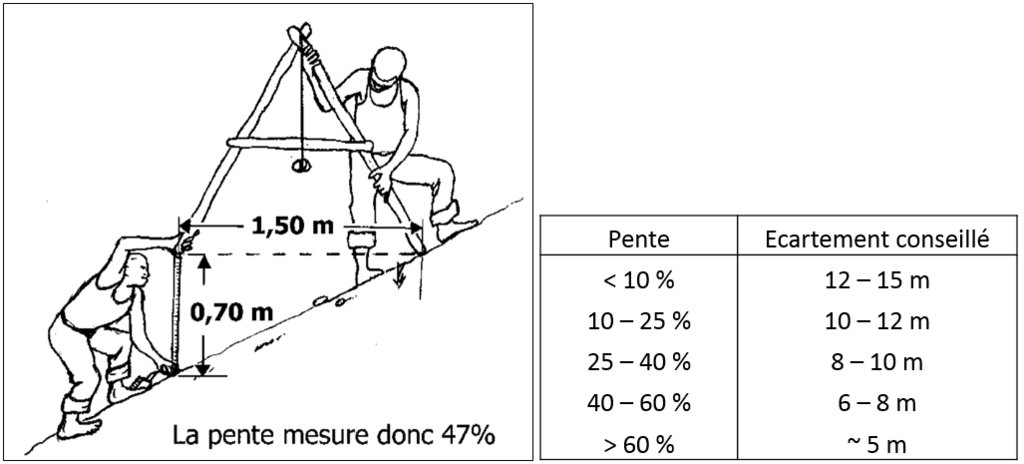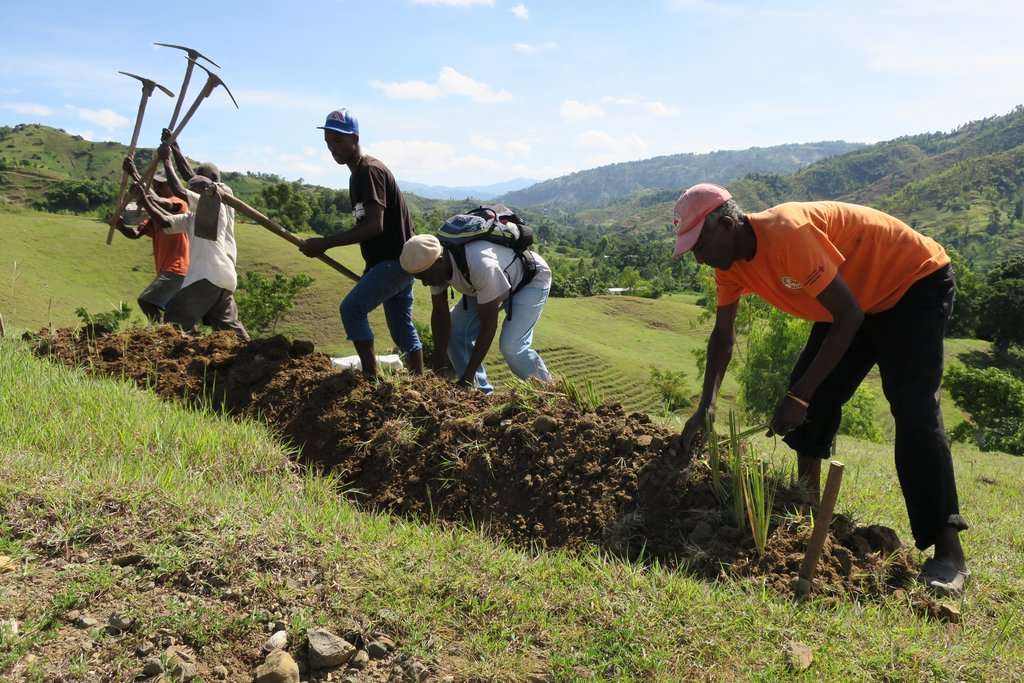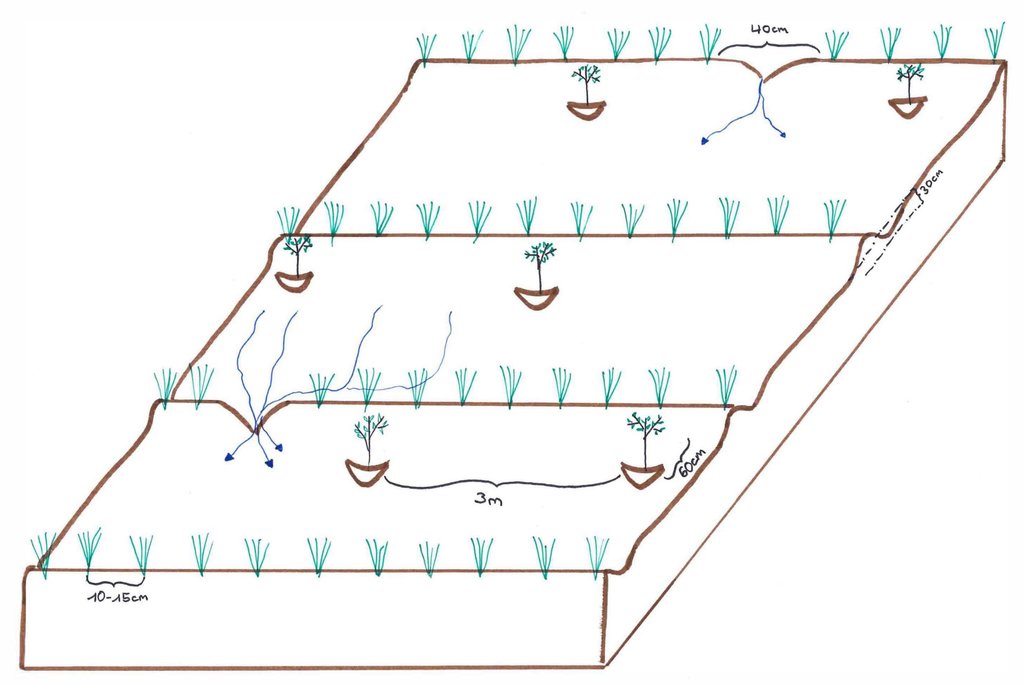Progressive bench terraces formed by a vetiver hedge system and trees [Haiti]
- Criação:
- Atualização:
- Compilador/a: Joana Eichenberger
- Editores: Hanspeter Liniger, Jean Carls Dessin
- Revisor: Hanspeter Liniger
Ranp vivan (fran. rampes vivantes)
technologies_3223 - Haiti
- Resumo completo em PDF
- Resumo completo em PDF para impressão
- Resumo completo no navegador
- Resumo completo (sem formatação)
- Progressive bench terraces formed by a vetiver hedge system and trees: 23 de Fevereiro de 2019 (inactive)
- Progressive bench terraces formed by a vetiver hedge system and trees: 16 de Junho de 2020 (inactive)
- Progressive bench terraces formed by a vetiver hedge system and trees: 16 de Abril de 2020 (inactive)
- Terrassement progressif à vétiver: 16 de Fevereiro de 2019 (inactive)
- Progressive bench terraces formed by a vetiver hedge system and trees: 27 de Junho de 2021 (public)
Veja as seções
Expandir tudo Recolher tudo1. Informação geral
1.2 Detalhes do contato das pessoas capacitadas e instituições envolvidas na avaliação e documentação da tecnologia
Technician:
Haiti
Nome do projeto que facilitou a documentação/avaliação da Tecnologia (se relevante)
Onsite and Offsite Benefits of SLMNome da(s) instituição(ões) que facilitou(ram) a documentação/ avaliação da Tecnologia (se relevante)
Swiss Red Cross (Swiss Red Cross) - Suíça1.3 Condições em relação ao uso da informação documentada através de WOCAT
O/a compilador/a e a(s) pessoa(s) capacitada(s) aceitam as condições relativas ao uso de dados documentados através da WOCAT:
Sim
1.4 Declaração de sustentabilidade da tecnologia descrita
A tecnologia descrita aqui é problemática em relação a degradação da terra de forma que não pode ser declarada uma tecnologia de gestão sustentável de terra?
Não
1.5 Referência ao(s) questionário(s) sobre abordagens GST (documentado(s) usando WOCAT)

Afforestation [Haiti]
Dans les mornes à Léogâne, la Croix Rouge Suisse (CRS) pratique la reforestation en participation communautaire.
- Compilador/a: Joana Eichenberger
2. Descrição da tecnologia de GST
2.1 Descrição curta da tecnologia
Definição da tecnologia:
Progressive terracing technology is established through successive deposits of sediments behind (upstream) any anti-erosional structure, in this case contour strips of vetiver grass (vetiveria zizanioides). To better stabilize the slopes in the long-term, trees are planted downstream of the vetiver hedges.
2.2 Descrição detalhada da tecnologia
Descrição:
Vetiver hedges are applied to prevent degradation and increase slope stabilization on areas prone to erosion. In Haiti, the Swiss Red Cross (SRC) has used cross-slope vetiver hedges as a restoration measure where soil has been degraded by surface erosion. Terraces are progressively formed and these reshape steep-sloped terrain into a succession of platforms with little or no gradient. Over time, these areas receive deposits of sediments from upstream: these sediments are captured by the terraces. Vetiver grass is used to establish anti-erosive structures because it is a common, deep-rooted species that can also be cut and used as mulch. Below the vetiver hedges, fruit trees may be planted to better stabilize the soil and simultaneously improve food security. However, if the soil is too degraded, forest trees are an alternative as they are less demanding. Between the vetiver hedges, land users can cultivate crops. It is recommended not to plant root crops (potatoes, cassava etc) or even groundnuts, but rather to plant legumes that bear fruit above ground and fix nitrogen, and perennial crops. Vetiver may be cut and used for mulching on the terrace beds.
This technology has several on- and offsite benefits. Besides stabilizing slopes and reducing landslide risks, vetiver strips are proven to reduce and retain surface runoff in ditches just above the hedges. Therefore, rainfall water can infiltrate more easily and recharge groundwater. Another onsite advantage is the accumulation of fertile sediments on the terrace beds, which support cropping. Offsite benefits include downstream protection for communities and agricultural fields against landslides, floods and siltation. Despite these advantages, land users claim there is significant loss of arable area when applying this technology. Farmers tend to exploit their plots of cultivated land, and only apply vetiver terraces when the soil is completely degraded. This, however, means that the soil needs time to regenerate before it can be cultivated again. Therefore, although very protective, this technology is not necessarily productive immediately after its implementation on heavily degraded soil. Furthermore, the vetiver grass itself has little use for the land users. Although its roots contain aromatic oil that is highly sought after in the cosmetic industry, land users should not dig up vetiver roots as this would severely weaken the stabilizing function of the technology.
2.3 Fotos da tecnologia
2.5 País/região/locais onde a tecnologia foi aplicada e que estão cobertos nesta avaliação
País:
Haiti
Região/Estado/Província:
Département de l'Ouest
Especificação adicional de localização:
Léogâne
Especifique a difusão da tecnologia:
- Uniformemente difundida numa área
Se a área precisa não for conhecida, indicar a área aproximada coberta:
- 0,1-1 km2
O(s) local(is) tecnológico(s) está(ão) localizado(s) em uma área permanentemente protegida?
Não
Map
×2.6 Data da implementação
Indique o ano de implementação:
2014
2.7 Introdução da tecnologia
Especifique como a tecnologia foi introduzida:
- através de projetos/intervenções externas
3. Classificação da tecnologia de GST
3.1 Principal/principais finalidade(s) da tecnologia
- Melhora a produção
- Reduz, previne, recupera a degradação do solo
- Protege uma bacia/zonas a jusante – em combinação com outra tecnologia
- Reduzir riscos de desastre
- Adaptar a mudanças climáticas/extremos e seus impactos
- adapt to steep slopes
3.2 Tipo(s) atualizado(s) de uso da terra onde a tecnologia foi aplicada

Terra de cultivo
- Cultura anual
- Cultura perene (não lenhosa)
Cultivo anual - Especificar culturas:
- culturas de oleaginosas - amendoim
- cereais - milho
- Legumes e leguminosas - feijão
- culturas de raízes/tubos - batata doce, inhame, taro/cocoyam, outros
Cultivo perene (sem lã) - Especificar culturas:
- banana/planta/abacá
- pigeon peas
Número de estações de cultivo por ano:
- 2
Especifique:
Mar-May and Sep-Oct
O cultivo entre culturas é praticado?
Sim
Em caso afirmativo, especifique quais são as culturas intercultivadas:
pigeon peas and sweet potatoes

Floresta/bosques
- Plantação de árvores, reflorestamento
Plantação de árvores, florestamento: Especificar a origem e composição das espécies:
- Variedades mistas
As árvores especificadas acima são decíduas ou perenes?
- decíduo
Produtos e serviços:
- Frutas e nozes
- Conservação/proteção da natureza
Comentários:
This technology can be implemented wherever slopes are being cultivated. In Haiti, the technology is usually used as a restoration measure when the soil has already been degraded by weeded/ ploughed crops.
3.3 O uso do solo mudou devido à implementação da Tecnologia?
O uso do solo mudou devido à implementação da Tecnologia?
- Sim (Por favor, preencha as perguntas abaixo com relação ao uso do solo antes da implementação da Tecnologia)
Uso do solo misturado dentro da mesma unidade de terra:
Não

Terra de cultivo
- Cultura anual
- Cultura perene (não lenhosa)
Cultivo anual - Especificar culturas:
- culturas de oleaginosas - amendoim
- cereais - milho
- Legumes e leguminosas - feijão
- culturas de raízes/tubos - batata doce, inhame, taro/cocoyam, outros
Cultivo perene (sem lã) - Especificar culturas:
- banana/planta/abacá
- cana-de-açúcar
- pigeon peas
O cultivo entre culturas é praticado?
Sim
Em caso afirmativo, especifique quais são as culturas intercultivadas:
pigeon peas and sweet potatoes

Terra improdutiva
Especifique:
The soil has been too degraded by the weeded/ploughed crop practice and has become unproductive.
3.4 Abastecimento de água
Abastecimento de água para a terra na qual a tecnologia é aplicada:
- Precipitação natural
3.5 Grupo de GST ao qual pertence a tecnologia
- Agrofloresta
- Medidas de curva de nível
- Redução de riscos de desastre baseada no ecossitema
3.6 Medidas de GST contendo a tecnologia

Medidas agronômicas
- A2: Matéria orgânica/fertilidade do solo

Medidas vegetativas
- V1: cobertura de árvores/arbustos
- V2: gramíneas e plantas herbáceas perenes

Medidas estruturais
- S1: Terraços
Comentários:
A2: Vetiver grass can be cut and used for mulching.
V1: The SRC combines the technology of progressive terracing with vetiver hedges with reforestation.
3.7 Principais tipos de degradação da terra abordados pela tecnologia

Erosão do solo pela água
- Wt: Perda do solo superficial/erosão de superfície
- Wg: Erosão por ravinas/ravinamento
- Wm: movimento de massas/deslizamentos
- Wo: efeitos de degradação externa

Degradação da água
- Ha: aridificação
- Hs: mudança na quantidade de água de superfície
- Hg: mudança no lençol freático/aquífero
- Hp: declínio da qualidade de água de superfície
Comentários:
Hg: assumption
3.8 Redução, prevenção ou recuperação da degradação do solo
Especifique o objetivo da tecnologia em relação a degradação da terra:
- Reduzir a degradação do solo
- Recuperar/reabilitar solo severamente degradado
Comentários:
Ideally, the technique would be applied to prevent degradation, but in Haiti, it is used as a measure to reduce land degradation and to restore severely degraded land.
4. Especificações técnicas, implementação de atividades, entradas e custos
4.1 Desenho técnico da tecnologia
Especificações técnicas (relacionada ao desenho técnico):
In order to implement this technology, the average slope has to be measured first. This is done with a "A-level"-called instrument. By placing one foot to the A-level and raising the lower foot (downstream in the direction of the slope), the A-level should be placed in a horizontal position. The slope corresponds to p=h/l*100, for p = slope, h = distance from the downstream foot of A-level to the ground, and l = distance between the two feet of level A. The average slope defines the distance between the vetiver lines. The steeper the slope, the smaller the distance.
Autor:
Régis and Roy
Data:
1999
Especificações técnicas (relacionada ao desenho técnico):
After having calculated the average slope of the terrain, one can start picketing the contour lines where the vetivers will be planted. First, an alignment in the direction of the slope from upstream to downstream is done by planting stakes. The first stake is placed at the upper limit of the plot, the distance the other stakes is a function of the average slope of the terrain (here: 50% --> 7m). This alignment forms the baseline. Once the baseline is set, the contour lines can be picketed. This is done again with the A-level instrument.
Autor:
Régis and Roy
Data:
1999
Especificações técnicas (relacionada ao desenho técnico):
In a third step, channels (about 30cm deep) are dug following the picketed contour lines. The material removed is used to form ridges downstream of the channels. On the ridges, vetiver cuttings are planted every 10-15cm.
Autor:
Joana Eichenberger
Data:
03/10/2017
Especificações técnicas (relacionada ao desenho técnico):
It is recommended to leave a space of approx. 40cm in each line (see drawing). These spaces a) facilitate the passage for the land users once the vetiver grass is high and b) make it possible for extra water to escape (if there is too much water accumulated in the channels, the ridgesmay break). 60cm downstream of the vetiver hedges, fruit or forest tree seedlings are planted every 3m. After about three months, the roots of the vetivers are deep enough. Depending on the soil degradation’s degree, land users may begin to cultivate the spaces between the lines.
Autor:
Joana Eichenberger
Data:
29/06/2018
4.2 Informação geral em relação ao cálculo de entradas e custos
Especifique como custos e entradas foram calculados:
- Por unidade de tecnologia
Especifique a unidade:
Vetiver line
Especificar as dimensões da unidade (se for relevante):
200m
Outro/moeda nacional (especifique):
HTG
Se for relevante, indique a taxa de câmbio do USD para moeda local (por exemplo, 1 USD = 79,9 Real): 1 USD =:
62,0
Indique a média salarial da mão-de-obra contratada por dia:
200 HTG per person and day
4.3 Atividades de implantação
| Atividade | Periodicidade (estação do ano) | |
|---|---|---|
| 1. | If necessary: deforest the plot | |
| 2. | Measure the slope with A-level and calculate the necessary distance between the lines of vetiver | |
| 3. | Mark out the contour lines (put a stake every 3m) | Beginning of the rainy season so that the vetiver can grow well -> March / April |
| 4. | Dig a channel following marked contour lines | March / April |
| 5. | Plant the vetiver seedlings every 10-15cm on the ridges of soil below(downstream) the canal | March / April |
| 6. | Plant the tree seedlings every 3m below (downstream) the vetiver lines | March / April |
4.4 Custos e entradas necessárias para a implantação
| Especifique a entrada | Unidade | Quantidade | Custos por unidade | Custos totais por entrada | % dos custos arcados pelos usuários da terra | |
|---|---|---|---|---|---|---|
| Mão-de-obra | Unskilled labourer | person-days | 20,0 | 200,0 | 4000,0 | 100,0 |
| Mão-de-obra | Skilled labourer | person-days | 5,0 | 1000,0 | 5000,0 | |
| Equipamento | Machete | pieces | 1,0 | 5,0 | 5,0 | 100,0 |
| Equipamento | Pickaxe | pieces | 3,0 | 5,0 | 15,0 | 100,0 |
| Equipamento | A-level | pieces | 1,0 | 5,0 | 5,0 | 100,0 |
| Equipamento | Hoe | pieces | 5,0 | 5,0 | 25,0 | 100,0 |
| Material vegetal | Vetiver grass | cuttings | 2000,0 | 2,0 | 4000,0 | |
| Material vegetal | Trees | cuttings | 67,0 | 50,0 | 3350,0 | |
| Custos totais para a implantação da tecnologia | 16400,0 | |||||
| Custos totais para o estabelecimento da Tecnologia em USD | 264,52 | |||||
Se o usuário da terra arca com menos que 100% dos custos, indique quem cobre os custos remanescentes:
Unskilled labour is provided by the community based organizations (OCB). The Swiss Red Cross offers a technician (skilled labor). The equipment (hoes, picks, ...) are provided by labouers themselves or the OCBs. Vetiver and tree cuttings are provided by the community.
4.5 Atividades recorrentes/manutenção
| Atividade | Periodicidade/frequência | |
|---|---|---|
| 1. | Replant dead cuttings | 2 times a year |
| 2. | Reparing broken ridges | 2 times a year |
| 3. | Verify if ridges are ok | In the beginning once a month, after that only once every three months |
| 4. | Cultivate normally | From tree months after implementation |
4.6 Custos e entradas necessárias pata a manutenção/atividades recorrentes (por ano)
| Especifique a entrada | Unidade | Quantidade | Custos por unidade | Custos totais por entrada | % dos custos arcados pelos usuários da terra | |
|---|---|---|---|---|---|---|
| Mão-de-obra | Land user and his family (monthly check, 1/2 day of work for 200m) | person-days | 6,0 | 200,0 | 1200,0 | 100,0 |
| Mão-de-obra | Replanting dead cuttings and reparing ridges (2 times a year total 5 working days for 20 people) | person-days | 100,0 | 200,0 | 20000,0 | 100,0 |
| Equipamento | Hoe | pieces | 1,0 | 5,0 | 5,0 | 100,0 |
| Material vegetal | Vetiver cuttings replaced after rainy season (5%) | cuttings | 65,0 | 2,0 | 130,0 | |
| Material vegetal | Vetiver cuttings replaced after dry period (40%) | cuttings | 533,0 | 2,0 | 1066,0 | |
| Custos totais para a manutenção da tecnologia | 22401,0 | |||||
| Custos totais de manutenção da Tecnologia em USD | 361,31 | |||||
Se o usuário da terra arca com menos que 100% dos custos, indique quem cobre os custos remanescentes:
Labor is provided by the OCBs. The equipment (hoes, picks, ...) are provided by labourers themselves or OCBs. Vetiver and tree cuttings are provided by the community
Comentários:
The costs depend a lot on the proportion of the damage and the damage depends on the weather. It is recommended to implement the measurement at the begining of the rainy season.
Land users have the necessary tools (the 5 HTGs are budgeted as compensation cost for using their own tools).
4.7 Fatores mais importantes que afetam os custos
Descreva os fatores mais determinantes que afetam os custos:
1) Skilled labourers
2) Maintenance costs depends very much on the weather: if it rains too much, runoff destroys the ridges by forming gullies and removing the vetiver cuttings which were not sufficiently rooted. If it does not rain enough during the first weeks, the vetivers can not form roots, dry out and must be replaced.
5. Ambiente natural e humano
5.1 Clima
Precipitação pluviométrica anual
- <250 mm
- 251-500 mm
- 501-750 mm
- 751-1.000 mm
- 1.001-1.500 mm
- 1.501-2.000 mm
- 2.001-3.000 mm
- 3.001-4.000 mm
- > 4.000 mm
Especificações/comentários sobre a pluviosidade:
The windward sides (north-facing slopes) receive more rain than the leeward sides.
Léogâne has a tropical climate with a rainy season ranging from April to November (with two peaks in April-May and August-October) and a dry season from the end of November to March. The relative decrease in rainfall in June and July is called the "mid-summer drought". Due to climate change, the rainy season tends to start later than it used to.
Zona agroclimática
- Subúmido
Mean annual temperature: 25-27°C
5.2 Topografia
Declividade média:
- Plano (0-2%)
- Suave ondulado (3-5%)
- Ondulado (6-10%)
- Moderadamente ondulado (11-15%)
- Forte ondulado (16-30%)
- Montanhoso (31-60%)
- Escarpado (>60%)
Formas de relevo:
- Planalto/planície
- Cumes
- Encosta de serra
- Encosta de morro
- Sopés
- Fundos de vale
Zona de altitude:
- 0-100 m s.n.m.
- 101-500 m s.n.m.
- 501-1.000 m s.n.m.
- 1.001-1.500 m s.n.m.
- 1.501-2.000 m s.n.m.
- 2.001-2.500 m s.n.m.
- 2.501-3.000 m s.n.m.
- 3.001-4.000 m s.n.m.
- > 4.000 m s.n.m.
Indique se a tecnologia é aplicada especificamente em:
- Não relevante
5.3 Solos
Profundidade do solo em média:
- Muito raso (0-20 cm)
- Raso (21-50 cm)
- Moderadamente profundo (51-80 cm)
- Profundo (81-120 cm)
- Muito profundo (>120 cm)
Textura do solo (solo superficial):
- Grosso/fino (arenoso)
- Médio (limoso, siltoso)
Textura do solo (>20 cm abaixo da superfície):
- Grosso/fino (arenoso)
- Médio (limoso, siltoso)
Matéria orgânica do solo superficial:
- Baixo (<1%)
Caso disponível anexe a descrição completa do solo ou especifique as informações disponíveis, p. ex. tipo de solo, PH/acidez do solo, nitrogênio, capacidade de troca catiônica, salinidade, etc.
In Haiti this technology is applied on very degraded sites with very shallow soil. But normally it is advisable to have a ground of a minimum of 25cm of depth (Régis and Roy 1999).
The technology can be applied everywhere, therefore, the soil can be sandy, loamy/silty or clay.
5.4 Disponibilidade e qualidade de água
Lençol freático:
5-50 m
Disponibilidade de água de superfície:
Médio
Qualidade da água (não tratada):
Água potável precária (tratamento necessário)
A salinidade da água é um problema?
Não
Ocorre inundação da área?
Não
5.5 Biodiversidade
Diversidade de espécies:
- Alto
Diversidade de habitat:
- Alto
5.6 Características dos usuários da terra que utilizam a tecnologia
Sedentário ou nômade:
- Sedentário
Orientação de mercado do sistema de produção:
- misto (subsistência/comercial)
Rendimento não agrícola:
- Menos de 10% de toda renda
Nível relativo de riqueza:
- Pobre
Indivíduos ou grupos:
- Grupos/comunidade
Nível de mecanização:
- Trabalho manual
Gênero:
- Homens
Idade dos usuários da terra:
- Jovens
- meia-idade
Indique outras características relevantes dos usuários da terra:
Land users age: young, middle-aged and elderly.
5.7 Área média de terrenos utilizados pelos usuários de terrenos que aplicam a Tecnologia
- < 0,5 ha
- 0,5-1 ha
- 1-2 ha
- 2-5 ha
- 5-15 ha
- 15-50 ha
- 50-100 ha
- 100-500 ha
- 500-1.000 ha
- 1.000-10.000 ha
- > 10.000 ha
É considerado pequena, média ou grande escala (referente ao contexto local)?
- Pequena escala
- Média escala
5.8 Propriedade de terra, direitos de uso da terra e de uso da água
Propriedade da terra:
- Indivíduo, não intitulado
Direitos do uso da terra:
- Acesso livre (não organizado)
Direitos do uso da água:
- Acesso livre (não organizado)
- Comunitário (organizado)
5.9 Acesso a serviços e infraestrutura
Saúde:
- Pobre
- Moderado
- Bom
Educação:
- Pobre
- Moderado
- Bom
Assistência técnica:
- Pobre
- Moderado
- Bom
Emprego (p. ex. não agrícola):
- Pobre
- Moderado
- Bom
Mercados:
- Pobre
- Moderado
- Bom
Energia:
- Pobre
- Moderado
- Bom
Vias e transporte:
- Pobre
- Moderado
- Bom
Água potável e saneamento:
- Pobre
- Moderado
- Bom
Serviços financeiros:
- Pobre
- Moderado
- Bom
6. Impactos e declarações finais
6.1 Impactos no local mostrados pela tecnologia
Impactos socioeconômicos
Produção
Produção agrícola
Comentários/especificar:
When established on very degraded land, land users have to patient and wait the soil to recover. But in the long run agricultural production will increase.
Qualidade da safra
Comentários/especificar:
When established on very degraded land, land users have to patient and wait the soil to recover. But in the long run crop quality will increase.
Risco de falha de produção
Diversidade de produtos
Área de produção
Disponibilidade e qualidade de água
Disponibilidade de água potável
Renda e custos
Rendimento agrícola
Comentários/especificar:
When established on very degraded land, land users have to patient and wait the soil to recover. But in the long run farm income will increase.
Impactos socioculturais
Segurança alimentar/auto-suficiência
Comentários/especificar:
When established on very degraded land, land users have to patient and wait the soil to recover. But in the long run food security will increase.
Conhecimento de GST/ degradação da terra
Impactos ecológicos
Ciclo hídrico/escoamento
Quantidade de água
Qualidade de água
Escoamento superficial
Evaporação
Solo
Umidade do solo
Cobertura do solo
Perda de solo
Acumulação de solo
Ressecamento/ selagem do solo
Biodiversidade: vegetação, animais
Cobertura vegetal
Clima e redução de riscos de desastre
Impactos da inundação
Deslizamentos de terra/fluxos de escombros
Impactos da seca
Impactos de ciclones, temporais
Emissão de carbono e gases de efeito estufa
Microclima
Especificar a avaliação dos impactos no local (medidas):
The impacts are just estimates, they have not been quantified yet.
6.2 Impactos externos mostrados pela tecnologia
Disponibilidade de água
Caudal confiável e estável em período seco
Cheias de jusante
Sedimentação a jusante
Danos em áreas vizinhas
Danos na infraestrutura pública/privada
Especificar a avaliação dos impactos fora do local (medidas):
The impacts are just estimates, they have not been quantified yet.
6.3 Exposição e sensibilidade da tecnologia às mudanças climáticas graduais e extremos/desastres relacionados ao clima (conforme o ponto de vista dos usuários da terra)
Extremos (desastres) relacionados ao clima
Desastres meteorológicos
| Como a tecnologia lida com isso? | |
|---|---|
| Tempestade tropical | bem |
| Temporal local | bem |
Desastres climatológicos
| Como a tecnologia lida com isso? | |
|---|---|
| Seca | bem |
Desastres hidrológicos
| Como a tecnologia lida com isso? | |
|---|---|
| Deslizamento de terra | muito bem |
Comentários:
The first period of rain is shifting (March-May -> April-June);
For vetiver grass, the first 3 months are decisive: there must be neither too much nor too little rain. After these three months, the drought has a negligible impact.
The SRC receives many positive feedbacks on this technology. The communities appreciate its benefits.
6.4 Análise do custo-benefício
Como os benefícios se comparam aos custos de implantação (do ponto de vista dos usuários da terra)?
Retornos a curto prazo:
levemente positivo
Retornos a longo prazo:
positivo
Como os benefícios se comparam aos custos recorrentes/de manutenção(do ponto de vista dos usuários da terra)?
Retornos a curto prazo:
levemente positivo
Retornos a longo prazo:
positivo
Comentários:
When established on very degraded land, it is necessary to wait a few months / years until land users can enjoy the benefits of this technology.
6.5 Adoção da tecnologia
- 1-10%
De todos aqueles que adotaram a Tecnologia, quantos o fizeram espontaneamente, ou seja, sem receber nenhum incentivo/ pagamento material?
- 0-10%
6.6 Adaptação
A tecnologia foi recentemente modificada para adaptar-se as condições variáveis?
Sim
Outros (especificar):
Terrain conditions
Especifique a adaptação da tecnologia (desenho, material/espécie, etc):
The Swiss Red Cross has tried out this technology by using sugar cane instead of vetiver. But since vetiver has deeper roots and is more resistant to dry periods, the SRC abandoned the variation with sugar cane.
If the ground is too degraded it is not necessary to make long lines of vetiver with always the same distance between one and the other (see the photo under description). We must adapt to the terrain.
6.7 Pontos fortes/vantagens/oportunidades da tecnologia
| Pontos fortes/vantagens/oportunidades na visão do usuário da terra |
|---|
| vegetable matter for mulching |
| sediment retention |
| increased soil moisture |
| Pontos fortes/vantagens/oportunidades na visão do/a compilador/a ou de outra pessoa capacitada |
|---|
| smoothens the slope |
| recuces soil erosion |
| improves soil fertility |
6.8 Pontos fracos, desvantagens/riscos da tecnologia e formas de superá-los
| Pontos fracos/desvantagens/riscos na visão do usuário da terra | Como eles podem ser superados? |
|---|---|
| Land users believe this technology recuces the arable surface. | It is necessary to increase the land users awareness regarding the benefits of the technology, like for example the productivity which increases. |
| The implementation of the technology is very labour-intensive. | Show that other technologies give even more work (e.g. progressive terraces with dry stones) |
| Pontos fracos/vantagens/riscos na visão do/a compilador/a ou de outra pessoa capacitada | Como eles podem ser superados? |
|---|---|
| The technique with vetiver grass depends on rain and as a result it is more vulnerable than dry stone technology. | The dry stone technology is only applied where there are stones locally available. Otherwise buying the stones and transporting them would cost too much. |
7. Referências e links
7.1 Métodos/fontes de informação
- visitas de campo, pesquisas de campo
- entrevistas com especialistas em GST
Quando os dados foram compilados (no campo)?
28/09/2017
7.2 Referências às publicações disponíveis
Título, autor, ano, ISBN:
Policy Brief: Productive and protective land management – reducing disastrous floods and saving springs in Haiti Author: Eichenberger J, Liniger HP, Year: 2020
Disponível de onde? Custos?
https://www.wocat.net/en/projects-and-countries/projects/onsite-and-offsite-benefits-sustainable-land-management/haiti
Título, autor, ano, ISBN:
Video: Productive and protective land management – reducing disastrous floods and saving springs in Haiti Author: Liniger HP, Eichenberger J, Year: 2020
Disponível de onde? Custos?
https://vimeo.com/429957516
Links e módulos
Expandir tudo Recolher tudoLinks

Afforestation [Haiti]
Dans les mornes à Léogâne, la Croix Rouge Suisse (CRS) pratique la reforestation en participation communautaire.
- Compilador/a: Joana Eichenberger
Módulos
Não há módulos


